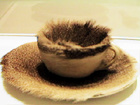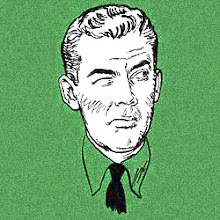 Parks was the first African American to work at Life. He co-founded Essence. His semi-autobiographical The Learning Tree would come out four years later, in '64, as would his film Flavio. He was an early contributor to the blaxploitation genre, and his son, Gordon Jr., directed Superfly. Again Life's intro to this "Kaleidoscope" notes that Parks chose the poems; already a main interest was race in America, yet none of the poems even hints at race or even really gestures toward the politics to which Parks would be so devoted. Perhaps this was all thematically truly before, for instance, he created a photo essay documenting the Selma to Montgomery march for Life (1963). At right, though, is a photo of Langston Hughes Park took in 1941; he apparently did not choose a Hughes poem for this spread.
Parks was the first African American to work at Life. He co-founded Essence. His semi-autobiographical The Learning Tree would come out four years later, in '64, as would his film Flavio. He was an early contributor to the blaxploitation genre, and his son, Gordon Jr., directed Superfly. Again Life's intro to this "Kaleidoscope" notes that Parks chose the poems; already a main interest was race in America, yet none of the poems even hints at race or even really gestures toward the politics to which Parks would be so devoted. Perhaps this was all thematically truly before, for instance, he created a photo essay documenting the Selma to Montgomery march for Life (1963). At right, though, is a photo of Langston Hughes Park took in 1941; he apparently did not choose a Hughes poem for this spread. In any case, Life is ecstatic about poetry's comeback: "Recordings of poems have rung up sales of more than two million albums. Poets are barnstorming the country, to recite their works before sellout audiences. In nightclubs and coffee houses, declaiming poetry is the rage, with out without musical accompaniment."

 Is '60 the moment when the end of the end of the Old Left had been reached and the New Left began to emerge? Is it the final ascendancy, in certain scenes at least, of poetic postmodernity? Surely the publication of Donald Allen's The New American Poetry that year suggests this, but then again--once again--we look back on "New" here and see continuity. The rhetoric of the Kennedy-Nixon contest made much less of a dent than everyone (at the time as well as since) claimed, so one wonders why were such great claims made?
Is '60 the moment when the end of the end of the Old Left had been reached and the New Left began to emerge? Is it the final ascendancy, in certain scenes at least, of poetic postmodernity? Surely the publication of Donald Allen's The New American Poetry that year suggests this, but then again--once again--we look back on "New" here and see continuity. The rhetoric of the Kennedy-Nixon contest made much less of a dent than everyone (at the time as well as since) claimed, so one wonders why were such great claims made?  Had we come to expect "1960" to be truly ubiquitously modern in a way that the 1950s really were not--not quite? And what specifically does "modern" mean in the Kennedyesque talk then and now about the torch being passed to a new generation, etc.? The First Lady really meant "modernist" when Camelotians said "modern." What about the others across the new young cultural leadership? I've been surprised by how frequently the
Had we come to expect "1960" to be truly ubiquitously modern in a way that the 1950s really were not--not quite? And what specifically does "modern" mean in the Kennedyesque talk then and now about the torch being passed to a new generation, etc.? The First Lady really meant "modernist" when Camelotians said "modern." What about the others across the new young cultural leadership? I've been surprised by how frequently the  "Beat movement" was covered in 1960 in the mainstream press. I was expecting a fair measure but I've found tonnage. 1960 was the year when the figure of the beat was beginning to find acceptance, although still 80% of these stories are mocking, rebels-without-cause condescension. For anyone whose analysis made an impact nationally, do these antipolitical adolescents count as part of the "new young cultural leadership"? No, but rather than the two being opposites, they fall along a Continuum of the New American. Now that's a change for '60.
"Beat movement" was covered in 1960 in the mainstream press. I was expecting a fair measure but I've found tonnage. 1960 was the year when the figure of the beat was beginning to find acceptance, although still 80% of these stories are mocking, rebels-without-cause condescension. For anyone whose analysis made an impact nationally, do these antipolitical adolescents count as part of the "new young cultural leadership"? No, but rather than the two being opposites, they fall along a Continuum of the New American. Now that's a change for '60.







